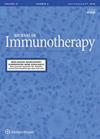利用转录组学数据和人工智能算法预测实体肿瘤中PD-L1的状态
IF 2.9
4区 医学
Q3 IMMUNOLOGY
引用次数: 0
摘要
程序性死亡配体-1 (PD-L1)免疫组织化学(IHC)通常用于预测对免疫检查点抑制剂(ICIs)的临床反应;然而,已经使用了多种检测方法和抗体。本研究旨在评估靶向转录组和人工智能(AI)与传统IHC相比在确定PD-L1 RNA表达水平和预测ICI反应方面的潜力。利用新一代测序技术(NGS)对396例实体瘤样本的RNA进行了靶向1408基因测序。在广泛的PD-L1表达水平范围内评估RNA表达和PD-L1 IHC。AI预测PD-L1状态。NGS评估的PD-L1 RNA水平在高表达范围和低表达范围内显示出强大的线性,使用NGS和IHC(肿瘤比例评分和肿瘤浸润免疫细胞)评估的PD-L1 RNA水平具有相似的模式。RNA测序提供了肿瘤微环境和免疫应答的深入信息,包括CD19、CD22、CD8A、CTLA4和PD-L2的表达状态。亚分析显示,mRNA表达与不同实体瘤类型的IHC(肿瘤比例评分和免疫细胞)持续相关。机器学习对PD-L1状态的预测准确率较高,曲线下面积在0.83 ~ 0.91之间变化。靶向转录组测序结合人工智能在预测PD-L1状态方面非常有用。通过NGS测量PD-L1 mRNA表达与通过IHC测量PD-L1表达预测ICI反应相当。RNA表达具有标准化和避免解释偏差的额外优势,以及对肿瘤微环境的深入评估。本文章由计算机程序翻译,如有差异,请以英文原文为准。
Predicting PD-L1 Status in Solid Tumors Using Transcriptomic Data and Artificial Intelligence Algorithms
Programmed death ligand-1 (PD-L1) immunohistochemistry (IHC) is routinely used to predict the clinical response to immune checkpoint inhibitors (ICIs); however, multiple assays and antibodies have been used. This study aimed to evaluate the potential of targeted transcriptome and artificial intelligence (AI) to determine PD-L1 RNA expression levels and predict the ICI response compared with traditional IHC. RNA from 396 solid tumors samples was sequenced using next-generation sequencing (NGS) with a targeted 1408-gene panel. RNA expression and PD-L1 IHC were assessed across a broad range of PD-L1 expression levels. AI was used to predict the PD-L1 status. PD-L1 RNA levels assessed by NGS demonstrated robust linearity across high and low expression ranges, and those assessed using NGS and IHC (tumor proportion score and tumor-infiltrating immune cells) had a similar pattern. RNA sequencing provided in-depth information on the tumor microenvironment and immune response, including CD19, CD22, CD8A, CTLA4 , and PD-L2 expression status. Subanalyses showed a sustained correlation of mRNA expression with IHC (tumor proportion score and immune cells) across different solid tumor types. Machine learning showed high accuracy in predicting PD-L1 status, with the area under the curve varying between 0.83 and 0.91. Targeted transcriptome sequencing combined with AI is highly useful for predicting PD-L1 status. Measuring PD-L1 mRNA expression by NGS is comparable to measuring PD-L1 expression by IHC for predicting ICI response. RNA expression has the added advantages of being amenable to standardization and avoiding interpretation bias, along with an in-depth evaluation of the tumor microenvironment.
求助全文
通过发布文献求助,成功后即可免费获取论文全文。
去求助
来源期刊

Journal of Immunotherapy
医学-免疫学
CiteScore
6.90
自引率
0.00%
发文量
79
审稿时长
6-12 weeks
期刊介绍:
Journal of Immunotherapy features rapid publication of articles on immunomodulators, lymphokines, antibodies, cells, and cell products in cancer biology and therapy. Laboratory and preclinical studies, as well as investigative clinical reports, are presented. The journal emphasizes basic mechanisms and methods for the rapid transfer of technology from the laboratory to the clinic. JIT contains full-length articles, review articles, and short communications.
 求助内容:
求助内容: 应助结果提醒方式:
应助结果提醒方式:


